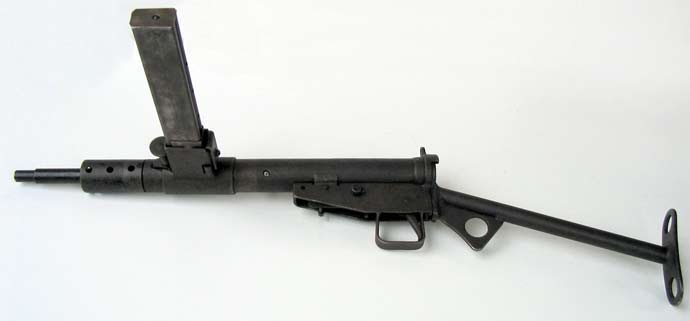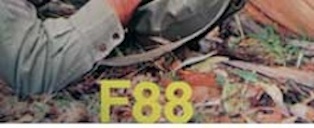
The Sten (or Sten gun) was a family of British 9 mm submachine guns used extensively by British and Commonwealth forces throughout World War II and the Korean War. They were notable for a simple design, low production cost, inaccuracy - and tendency to jam as in the assassination Reinhard Heydrich.
STEN is an acronym, cited as derived from the names of the weapon's chief designers, Major Reginald Shepherd and Harold Turpin, and EN for Enfield.[1] Over 4 million Stens in various versions were made in the 1940s.
The official designation "Carbine, Machine, Sten" should not be confused with the common understanding of carbine; the Sten was a typical, almost stereotypical submachine gun while the term carbine is used to refer to short, light rifles. The "Carbine, Machine" element of the designation was due to the British term for a submachine gun being a "Machine Carbine" in the earlier parts of the Second World War.
History
The Sten emerged while Britain was engaged in the Battle of Britain, facing invasion by Germany. The army was forced to replace weapons lost during the evacuation from Dunkirk while expanding at the same time. Prior to 1941 (and even later) the British were purchasing all the Thompson submachine guns they could from the United States of America, but this did not begin to meet demand. The American entry into the war at the end of 1941 placed an even bigger demand on the facilities making Thompsons. In order to rapidly equip a sufficient fighting force to counter the Axis threat, the Royal Small Arms Factory, Enfield, was commissioned to produce a significantly cheaper alternative.
The credited designers were Major R. V. Shepherd, OBE, Inspector of Armaments in the Ministry of Supply Design Department at The Royal Arsenal, Woolwich, (later Assistant Chief Superintendent at the Armaments Design Department) and Mr. Harold John Turpin, Senior Draughtsman of the Design Department of the Royal Small Arms Factory (RSAF) Enfield. Shepherd had been recalled to service after having retired and spending some time at BSA.
The Sten required a minimum amount of machining and manufacturing effort by using simple pressed metal components and minor welding. Much of the production could be performed by small workshops and the firearms assembled at the Enfield site. Over the period of manufacture the Sten design was further simplified: the most basic model, the Mark III, could be produced from five man-hours work. Some of the cheapest versions were made from only 47 different parts. It was distinctive for its bare appearance (just a pipe with a metal loop for a stock), and its horizontal magazine. The Mark I was a more finely finished weapon with a wooden foregrip and handle; some later versions were not quite as spartan. Anecdotal evidence suggests British soldiers did not like the unreliable and inaccurate Sten gun, swapping it for a captured German MP40 whenever possible; it seems that the German weapon was superior.
The Sten was slowly withdrawn from British service in the 1960s, and was replaced by the Sterling SMG. The other Commonwealth nations made or adopted their own replacements. The Sten was used extensively by Jewish partisans during the Israeli War of Independence.
Design
The Sten gun was chambered for the 9x19mm Parabellum pistol cartridge. The Sten was small and could be stripped down into a set of easily concealed components and was therefore particularly suited to partisan operations on the continent or in Special Operations Executive operations in German occupied France. Guerrilla fighters in Europe became adept at repairing, modifying and eventually scratch-building clones of the Sten (over 2,000 Stens and about 500 of similar Błyskawica SMGs were manufactured in occupied Poland).
The Sten was a simple, open bolt, blowback operated, selective-fire firearm. Single shots and full automatic fire were selected by a cross-bolt type push-button located in front and above the trigger. The tubular receiver and the barrel sleeve were made from rolled steel. It was fed from a box magazine attached to the housing on the left side of the gun. Various stocks were used with different models, all steel skeleton and tubular stocks to wooden stocks and pistol grips. The sights were fixed, consisting of a rear peep and front blade, zeroed to a nominal 100 yards.[2]
Stoppages could occur due to the magazine, a direct copy of the one used in the German Erma MP38/MP40. The magazine had two columns of tapered 9 mm cartridges arranged side-by-side in a zig-zag manner. To allow the magazine box to be straight, the front of the magazine was tapered to complement the taper of the cartridges. While other staggered magazines fed from both the left and right positions, the Sten magazine required the cartridges to gradually merge at the top of the magazine to form a single column. Any dirt or foreign matter in this taper area could cause feed malfunctions. Additionally, the walls of the magazine lip had to endure the full stresses of the rounds being pushed in by the spring. This could result in deformation of the magazine lips, resulting in misfeeds. To facilitate easier loading to the great resistance when attempting to push the cartridges down to insert the next one, a magazine filler tool was developed and formed part of the weapon's kit. Modern 9 mm magazines, such as those used by the Sterling SMG, are curved and feed both sides to avoid this problem.
A well-maintained Sten gun is a devastating close-range weapon. If a Sten does jam with the bolt forward, standard practice to clear it is as follows: tilt the Sten to the right to allow gravity to pull jammed rounds out through the cartridge ejection port, whilst recocking the weapon. Then the weapon is fired again as normal. An easy action to memorise even under stress.
The slot on the side of the body where the cocking knob ran was a target of criticism, as the long opening could allow foreign objects to enter. On the other hand, a beneficial side-effect of the Sten's minimalist design was that it would fire without any lubrication. This was useful in desert environments where oil attracts and retains dust.
The MK II and MK III Stens could accidentally discharge if dropped whilst the gun was cocked. This was particularly true of early Stens using bronze bolts, where the sear projection underneath the bolt could wear down more easily than ones made of case-hardened steel.
The Sten underwent various design improvements over the course of the war. For example, the Mark 4 cocking handle and corresponding hole drilled in the receiver were created in order to prevent an accidental discharge issue. However, most changes to the production process were more subtle, designed to give greater ease of manufacture and increased reliability. Sten guns of late 1942 and beyond were highly effective weapons. Such was the ease of manufacture that the Germans also produced a version of the Sten, the MP 3008, late in the war.

Austen MK I The Mark I Austen (from "Australian Sten") was a 9 millimeter Australian submachine gun derived from the British Sten gun developed during the Second World War by the Lithgow Small Arms Factory. Approximately 45,000 Austens were produced from 1942 to 1944. They remained in service as a standard weapon of the Australian Army until 1966.





